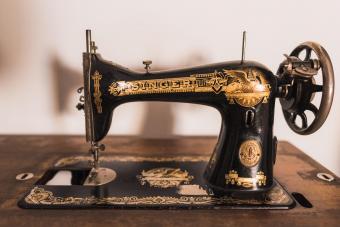Useful and Beautiful

Many people that enjoy sewing use antique sewing machines to create beautiful garments and household items. These functional antiques offer a way to create, often without the need for electricity. What's more, antique sewing machines are beautiful, and many people collect these treasures.
Invention of Antique Sewing Machines

During the early 1800s, there were many attempts to make a functional sewing machine. However, it was in 1846 that Elias Howe patented the first automatic sewing machine, which used a hand cranked shuttle system that moved from side to side creating a lockstitch.
Antique Singer Sewing Machine

In 1850, Isaac Singer patented the first sewing machine with a needle that moved in an up and down direction, creating a lockstitch. Powered by a hand crank, these were the first sewing machines that were suitable for home use. Today, antique Singer sewing machines are very popular with collectors.
The Presser Foot

Around 1900, another invention helped revolutionize the industry. This was the presser foot. The job of the presser foot is to hold the material in place as it feeds the fabric through the sewing machine.
Treadle Sewing Machine

In the early 1850s, Isaac Singer patented the treadle sewing machine. The sewing machine was powered using a slight rocking foot motion to move the rocker pedal up and down. The treadle is also referred to as the foot pedal. This spun a wheel, and a belt translated that motion to operate the sewing machine.
Sewing Machines in Cabinets

As the design of sewing machines advanced, manufacturers began to sell them in furniture-quality cabinets. Made of wood and cast iron, these cabinets could store the machine when it wasn't in use and also act as a functional sewing table. Many had drawers or cupboards for storing sewing supplies and machine components. Today, complete antique sewing machines with cabinets can be quite valuable.
Sewing Machine Manufacturers

In the United States during the late 1800s and early 1900s, dozens of companies were manufacturing sewing machines for home use. In addition to Singer and Howe, several popular companies of the times included American, Sears, White sewing machines, and Jones. Other brands you may encounter in antique stores are National sewing machines and the iconic Willcox & Gibbs.
Child’s Sewing Machine

Children's sewing machines became popular in the late 1800s and early 1900s. Most of the early miniature sewing machines made for children were powered by a hand crank and were made of cast iron painted black.
Decorative Childs Sewing Machine

As you can see by this beautiful decorative example of a child's sewing machine from the early 1900s, children's machines were not just functional. They were also very pretty. Popular manufacturers of these small sewing machines were Singer and Sears.
Sign up for our newsletter featuring all the latest stories and products we love.
Side Details

In fact, almost all sewing machines from the late 1800s and early 1900s are incredibly lovely. The side view of this antique sewing machine beautifully illustrates the elaborate details of the presser foot, plate, and threading mechanism.
Decorative and Functional

Many antique sewing machines have beautiful painted floral designs or decals, too. These can add to the value of the machine, and many decal patterns are especially coveted. This crank machine is what is called a "fiddle base," and even though the decals are worn, they are still very pretty.
An Antique You Can Use

One of the great things about antique sewing machines from any era or manufacturer is that these are functional antiques. You can still sew on an antique machine, and in many cases, you can still get sewing machine parts to fix them. And you can store all your sewing notions in a vintage sewing box. You won't have all the complicated bells and whistles of newer electronic machines, but you'll have a beautiful piece of sewing history you can pass down through the generations.







